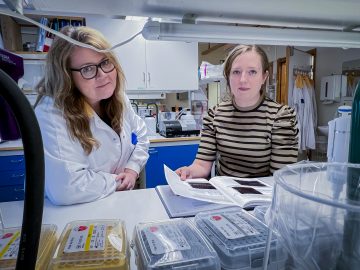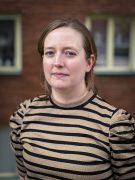AWARD. Karin Nilsson, currently a postdoc at the Department of Internal Medicine and Clinical Nutrition, receives the faculty-wide Thesis of the Year award at Sahlgrenska Academy 2023. In her thesis, she showed that the protein RSPO3 increases bone density, exposing a new target for the treatment of osteoporosis.
The prize “Thesis of the Year at Sahlgrenska Academy” has been awarded since 2009 and is funded by a donation from the Dr. Arnt Vestby Research Foundation. In total, seven prizes are awarded for the Thesis of the Year: one prize for each of the six departments and one major prize for the entire faculty, which for 2023 goes to Karin Nilsson. The award ceremony for the Thesis of the Year will take place on June 3, for specially invited guests.

“This award really means a lot to me and my colleagues. It is stimulating and very gratifying that more people than just those of us who worked on the studies think that our contribution is good and important,” says Karin Nilsson, who has worked as a postdoc in the group for the past year:
“I really enjoy the environment and my colleagues. I have received fantastic support, especially from my supervisors Sofia Movérare Skrtic and Claes Ohlsson. I am really grateful that was able to work so independently as a PhD student,” she says.
An unexplored link
Her thesis presents groundbreaking results in osteoporosis research. In particular, work on the RSPO3 protein has broken new ground. Karin Nilsson shows that mice lacking RSPO3 have reduced bone density and increased risk of fractures. In parallel, Karin’s colleagues, including PhD student Maria Nethander, have shown in human genetic studies that a fracture signal at the gene’s location in the genome can regulate the amount of RSPO3, and that bone density in the porous bone tissue called trabecular bone increases as the amount of protein increases.
The RSPO3 protein is an important but previously unexplored link in the cellular signaling that plays a major role in the development of osteoporosis, called WNT signaling. However, this signaling affects the whole body, not just how bones develop and function.

“RSPO3 could be developed as a future target for medical treatments that would not only inhibit bone breakdown like most of today’s osteoporosis drugs, but could strengthen and rebuild bone. I think it could work, but it would be a bit in the future. The treatment would have to be delivered specifically to the bones to be strengthened, to avoid undesirable effects, and such treatment would be very costly today,” says Karin Nilsson.
There is currently a few effective treatments that can strengthen bones for people with severe osteoporosis, but more safe alternatives are needed.
Devastating fractures

One in two women and one in four men in Sweden will suffer a fracture at some point due to osteoporosis. Such a fracture can be devastating. Bone fractures lead to reduced quality of life, reduced physical functioning and increased risk of morbidity and death. Of those who suffer a hip fracture, 25% die within a year.
“Today, osteoporosis is usually detected at the time of the first fracture, and by then it may be too late. I used to work in elderly care myself, and I have seen the impact of a fracture on an elderly person. Even when the fracture has healed, life will not be the same. The large negative impact of a fracture for the elderly became so clear to me then,” says Karin Nilsson.
Scientific excellence
Karin Nilsson defended her thesis at the end of May 2023. The four sub-studies were all published in reputable journals, including Nature Communications. In their nomination, Sofia Movérare Skrtic and Claes Ohlsson state that Karin Nilsson has shown impressive scientific excellence during her PhD studies, and that she has continuously developed her understanding of the methodology used in her work. In addition to RSPO3, the thesis also describes the NOTUM protein, which instead inhibits WNT signaling.
BY: ELIN LINDSTRÖM
ALL SEVEN PRIZE WINNERS
Sahlgrenska Academy
Karin Nilsson: NOTUM and RSPO3 in Bone – WNT signaling modulators regulating the skeleton; https://gupea.ub.gu.se/handle/2077/75182
Biomedicine
Slavica Janeva: Clinical significance of immunohistochemistry in breast cancer diagnostics; https://gupea.ub.gu.se/handle/2077/75206
Clinical sciences
Linnéa Lindroos: Obstetric Emergency Triage – A new mindset in obstetric emergency care in Sweden; https://gupea.ub.gu.se/handle/2077/77768
Medicine
Erik Stenkilsson Hoff: Pharmacological therapy in obstructive sleep apnea – Methodology and interventional aspects of carbonic anhydrase modulation; https://gupea.ub.gu.se/handle/2077/77777
Neuroscience and physiology
Emma Eckernäs: Pharmacokinetics and pharmacodynamics of the psychedelic compound DMT; https://gupea.ub.gu.se/handle/2077/78565
News article in the Staff Portal: Emma Eckernäs received the Thesis of the Year Award at the Institute of Neuroscience and Physiology
Odontology
Julia Olander: On biological response and wear particles around oral implants and implant components; https://gupea.ub.gu.se/handle/2077/78884
Health and Care Sciences
Nina Ekman: Development and testing af an observation-based method to assess person-centeredness in healthcare; https://gupea.ub.gu.se/handle/2077/75178












Leave a Comment